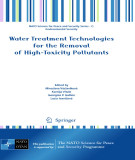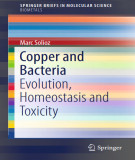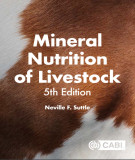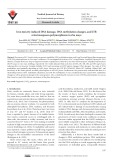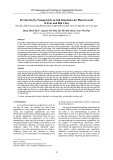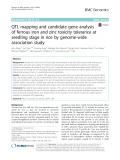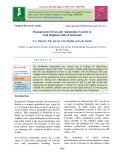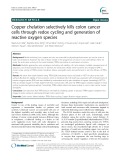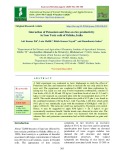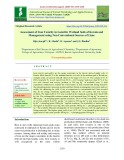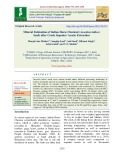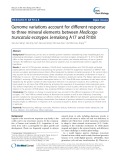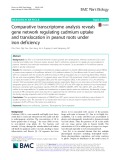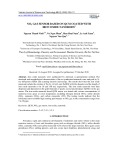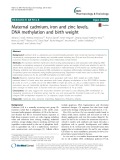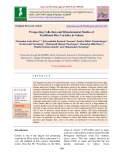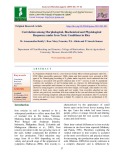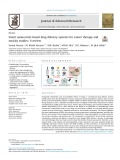
Iron toxicity
-
Ebook "Water treatment technologies for the removal of high-toxicity pollutants" process requires interdisciplinary approach; it is critically important to stimulate interactions between medical doctors, chemists, physicist, materials scientists, engineers and policy makers, which are already experienced in their specific areas. It is also our ethical obligation to preserve existing water resources and existing eco systems enhancing their biodiversity.
 338p
338p  giangdongdinh
giangdongdinh
 28-05-2024
28-05-2024
 1
1
 1
1
 Download
Download
-
Ebook "Copper and bacteria: Evolution, homeostasis and toxicity" summarizes the current knowledge of copper toxicity, homeostasis and resistance in bacteria, in which proteins like copper ATPases, copper chaperones and copper-responsive regulators of gene expression play major roles. The author also discusses the metallation of cuproenzymes. The evolution of the use of copper by cells and of copper-homeostatic proteins are is also considered in this brief.
 99p
99p  tracanhphuonghoa1007
tracanhphuonghoa1007
 22-04-2024
22-04-2024
 2
2
 2
2
 Download
Download
-
Part 2 book "Mineral nutrition of livestock" includes content: Iodine, iron, manganese, selenium, zinc, occasionally beneficial elements, potentially toxic elements, predicting mineral responses, minerals and humans.
 300p
300p  muasambanhan10
muasambanhan10
 03-04-2024
03-04-2024
 4
4
 1
1
 Download
Download
-
The impact of Fe2+ (iron)toxicity on genomic instability, DNA methylation status, and Long Terminal Repeat Retrotransposons (LTR RTs) polymorphisms on Zea mays is unknown. We investigated the toxicity of Fe2+ using Random Amplified Polymorphic DNA (RAPD), Coupled Restriction Enzyme Digestion-Random Amplification (CRED-RA) and Inter Retrotransposon Amplified Polymorphism (IRAP) assays in Zea mays seedlings, respectively.
 8p
8p  lyhuyenthu
lyhuyenthu
 31-01-2023
31-01-2023
 6
6
 2
2
 Download
Download
-
Iron oxide nanoparticles have been known to be non-toxic and are among the most widely used nanomaterials in life, from the medical, agricultural to environmental fields. However, so far, the understanding of the interaction of nanoparticles, in general, and iron oxide nanoparticles, in particular, with the environment and the flora and fauna ecosystems is still limited.
 8p
8p  viporsche
viporsche
 25-10-2022
25-10-2022
 20
20
 3
3
 Download
Download
-
Ferrous iron (Fe) and zinc (Zn) at high concentration in the soil cause heavy metal toxicity and greatly affect rice yield and quality. To improve rice production, understanding the genetic and molecular resistance mechanisms to excess Fe and Zn in rice is essential. Genome-wide association study (GWAS) is an effective way to identify loci and favorable alleles governing Fe and Zn toxicty as well as dissect the genetic relationship between them in a genetically diverse population.
 15p
15p  vilarryellison
vilarryellison
 29-10-2021
29-10-2021
 18
18
 1
1
 Download
Download
-
This element can be toxic under high concentrations (Nan et al., 2002). Zn being an essential micronutrient taken active part in metabolic activities of plants and is directly or indirectly required by several enzymatic systems auxin, protein synthesis, seed production, and rate of maturity.
 5p
5p  caygaocaolon11
caygaocaolon11
 21-04-2021
21-04-2021
 7
7
 1
1
 Download
Download
-
Since the acid sulphate soils of Kuttanad is an important problematic area with extreme acidity, toxicity of iron, aluminium coupled with deficiency of phosphorous, application of different amendments and other nutrients should be used for successful cultivation in these area.
 8p
8p  cothumenhmong9
cothumenhmong9
 18-01-2021
18-01-2021
 14
14
 1
1
 Download
Download
-
Metals including iron, copper and zinc are essential for physiological processes yet can be toxic at high concentrations. However the role of these metals in the progression of cancer is not well defined. Here we study the anti-tumor activity of the metal chelator, TPEN, and define its mechanism of action.
 12p
12p  vilisa271
vilisa271
 22-09-2020
22-09-2020
 19
19
 0
0
 Download
Download
-
A field experiment was conducted during Kharif 2011 in iron toxic low land soil of Central research Station, OUAT, Bhubaneswar. The experiment was conducted in RBD with three replications on a typical iron toxic Aeric Haplaquept soil with recommended dose of fertilizers (N: P: K) by taking rice cultivar ‘Jajati’ as a test crop. Twelve treatment combinations, consist of four levels of K (0, 40, 80 and 120 kg ha-1) and three levels of zinc (0, 2.5 and 5 kgha-1) were imposed on concerned plots.
 4p
4p  nguaconbaynhay7
nguaconbaynhay7
 15-08-2020
15-08-2020
 9
9
 1
1
 Download
Download
-
Iron toxicity and acidity are the major constraints in the laterite derived paddy soils of Kerala. More than 90 % of the midland lateritic rice soils in the northern part of Kerala are strongly acidic in reaction with pH values in the range of 4.5 to 5.5. The content of 0.1 N HCl extractable Fe in soil varied from 52.21 – 414.9 mg kg-1 and more than 50 % of the rice soils showed iron toxicity problem (> 250 mg kg-1 of available iron).
 10p
10p  caygaocaolon6
caygaocaolon6
 30-07-2020
30-07-2020
 23
23
 1
1
 Download
Download
-
Aesculus indica seeds were various treated under different processing techniques to achieve maximum removal its saponin/ aescin content which is toxic if consumed seeds as raw. The mineral viz. calcium, manganese, zinc, iron and copper were estimated.
 4p
4p  trinhthamhodang1213
trinhthamhodang1213
 02-06-2020
02-06-2020
 10
10
 1
1
 Download
Download
-
Resequencing can be used to identify genome variations underpinning many morphological and physiological phenotypes. Legume model plant Medicago truncatula ecotypes Jemalong A17 (J. A17) and R108 differ in their responses to mineral toxicity of aluminum and sodium, and mineral deficiency of iron in growth medium.
 11p
11p  viminato2711
viminato2711
 22-05-2020
22-05-2020
 6
6
 0
0
 Download
Download
-
Iron (Fe) is an essential element for plant growth and development, whereas cadmium (Cd) is nonessential and highly toxic. Previous studies showed that Fe deficiency enhanced Cd uptake and accumulation in peanuts.
 14p
14p  viharuno2711
viharuno2711
 24-04-2020
24-04-2020
 12
12
 0
0
 Download
Download
-
Iron oxide nanorods were synthesized by chemical co-precipitation method. The structural and morphological characteristics of the as-synthesized nanorods were analyzed by Xray diffraction (XRD) and scanning electron microscopy. The results show that the iron oxide nanorods include the mixture of Fe3O4, γ-Fe2O3 and FeOOH with the diameter and the length of iron oxide nanorods to be 30 and 100 nm, respectively. The iron oxide nanorods were then dispersed and deposited on the gold electrode of quartz crystal microbalance (QCM) for the gas sensor.
 8p
8p  nguyenminhlong19
nguyenminhlong19
 22-04-2020
22-04-2020
 30
30
 1
1
 Download
Download
-
Cadmium (Cd) is a ubiquitous and environmentally persistent toxic metal that has been implicated in neurotoxicity, carcinogenesis and obesity and essential metals including zinc (Zn) and iron (Fe) may alter these outcomes. However mechanisms underlying these relationships remain limited.
 9p
9p  vienzym2711
vienzym2711
 03-04-2020
03-04-2020
 6
6
 2
2
 Download
Download
-
The diagnosis of places of varietal diversity of rice in Guinea was made from survey data from several farms in 41 villages themselves distributed in the 2 natural regions of Lower Guinea and Forest Guinea. The descriptors used are the number of known varieties and varieties cultivated at different scales, as well as their utilization rate. The latter makes it possible to classify the Sativa and Glaberrima varieties at the village level and to identify improved and local varieties of notoriety.
 17p
17p  nguaconbaynhay4
nguaconbaynhay4
 22-03-2020
22-03-2020
 8
8
 2
2
 Download
Download
-
F2 population obtained from F1 cross between Tulasi (Most tolerant genotype) and CUL8709 (Most susceptible genotype). 300 F2 plants and their parents were screened at 800 ppm of Fe. Phenotyping screening of F2 plants under iron toxic levels indicated presence of wide variability for shoot length, root length, total number of roots, number of fresh roots, shoot weight, root weight and visual scoring for iron-toxicity symptoms. The measures of skewness and kurtosis for various traits revealed a large quantitative variability.
 9p
9p  chauchaungayxua1
chauchaungayxua1
 04-12-2019
04-12-2019
 18
18
 2
2
 Download
Download
-
F2 Population obtained from F1 cross between Tulasi (Most tolerant genotype) and CUL8709 (Most susceptible genotype). 300F2 plants and their parents were screened at 800 ppm of Fe. Phenotyping screening of F2 plants under iron toxic levels indicated that leaf bronzing is associated with growth reduction due to Fe2+ toxicity in this F2 population confirms the usefulness of leaf bronzing index as criterion for differentiating between genotypes susceptible and tolerance to iron toxicity.
 8p
8p  chauchaungayxua1
chauchaungayxua1
 04-12-2019
04-12-2019
 14
14
 1
1
 Download
Download
-
Nonspecific distribution and uncontrollable release of drugs in conventional drug delivery systems (CDDSs) have led to the development of smart nanocarrier-based drug delivery systems, which are also known as Smart Drug Delivery Systems (SDDSs). SDDSs can deliver drugs to the target sites with reduced dosage frequency and in a spatially controlled manner to mitigate the side effects experienced in CDDSs. Chemotherapy is widely used to treat cancer, which is the second leading cause of death worldwide.
 18p
18p  trinhthamhodang1
trinhthamhodang1
 14-11-2019
14-11-2019
 34
34
 0
0
 Download
Download
CHỦ ĐỀ BẠN MUỐN TÌM








